And just like that, after four years of quarter-final exits, Barcelona are through to the semi-finals of the Champions League once again. Even though it might have been shaky and more complicated than was predicted at first, the Catalans dispatched Manchester United and sealed the deal at the Camp Nou with a convincing 3-0 victory.
Lionel Messi made the difference and was once again Barcelona’s cheat code in completing this colossal achievement. But the visitors’ cameo appearance in the heart of Catalunya could’ve been much more than just that were it not for some individual blunders and missed chances that might haunt them, and their fans, for days to come.
Still, Barcelona are deservedly through as they were the better side across the two legs and they now await their next opponent in the chase for this illustrious trophy. But how exactly have they got past the Red Devils? This tactical analysis will try to answer that question.
Lineups
Barcelona (4-3-3)
Starting XI: Ter Stegen – Sergi, Piqué, Lenglet, Alba – Rakitić, Busquets, Arthur – Messi, Suárez, Coutinho
Bench: Cillessen, Semedo, Umtiti, Vidal, Aleñá, Malcom, Dembélé
Coach: Ernesto Valverde
Manchester United (4-1-4-1)
Starting XI: De Gea – Jones, Lindelöf, Smalling, Young – McTominay, Fred, Pogba – Lingard, Rashford, Martial
Bench: Romero, Dalot, Andreas, Matić, Mata, Alexis, Lukaku
Coach: Ole Gunnar Solskjær
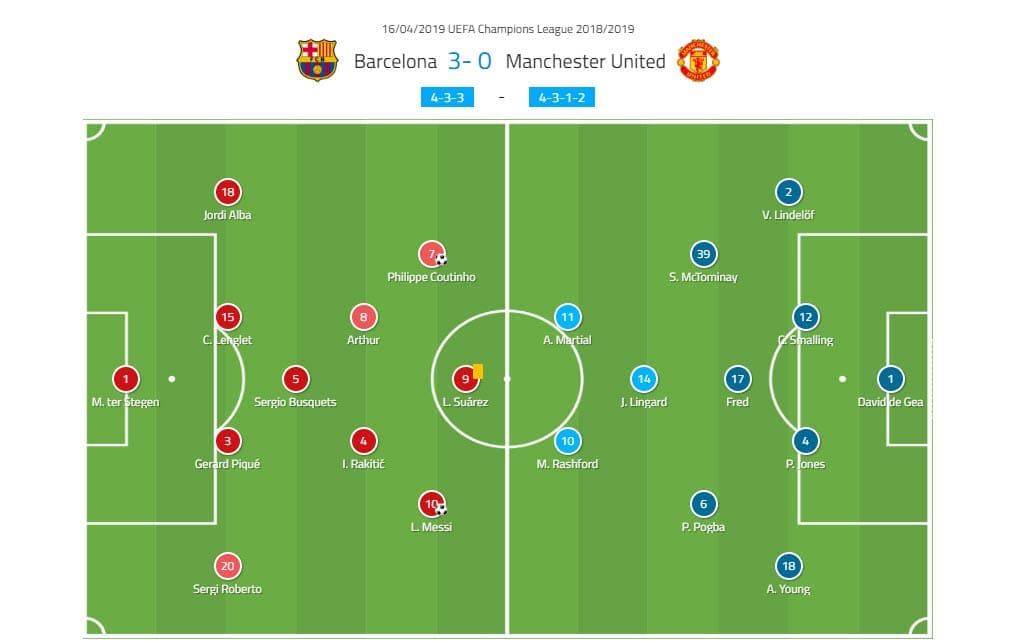
Barcelona’s setup
Having rested the entirety of his standard lineup, Ernesto Valverde had his first-choice troops at full strength and ready to wreak some havoc at the Camp Nou. Still, even though his choice of personnel is somewhat predictable, the usual suspects caused us headaches in predicting it.
Sergi Roberto turned out to be the chosen one at right-back, benching Nélson Semedo who was one yellow card away from suspension. This was a strategic decision for multiple reasons. This way the Portuguese speedster was guaranteed to be available for the trip to Anfield in the semi-finals, and Roberto’s attacking skill set suited Barcelona in their overall gameplan.
The next position that was under question was on the left wing where Philippe Coutinho still got the nod in front of Ousmane Dembélé. Once again, Valverde got it right with his decisions. There was also a slight possibility that Arturo Vidal would indeed be chosen in front of Arthur Melo but no such thing happened in the end.
Barcelona opted for their traditional 4-3-3 system and stayed faithful to it until the final whistle.
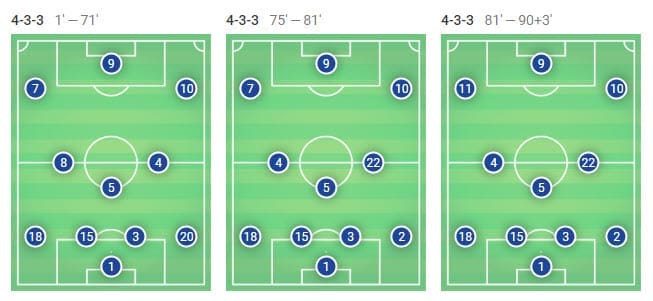
Manchester United’s setup
Even though their performance was much better in the first leg, Manchester United were somewhat forced to make changes for the return game at the Camp Nou. The suspension of Luke Shaw meant that Solskjær would have to find some unlikely solutions and implement makeshift ideas to make this work.
As a direct result of that, Ashley Young and Victor Lindelöf were the team’s full-backs next to the Phil Jones/Chris Smalling centre-back pairing. The centre of the field remained the same with Pogba, McTominay and Fred, but the first line of attack saw some more changes.
Both Jesse Lingard and Anthony Martial were given a chance right from the start as Romelu Lukaku and Diogo Dalot were perhaps unsurprisingly benched. The former failed to have the desired impact even though he did give a certain aspect to United’s attack, but the latter’s exclusion was the bigger question, and one Solskjær is yet to fully answer.
Manchester United were deployed in an interesting 4-3-1-2 system but interchanged through various different ones throughout the game.
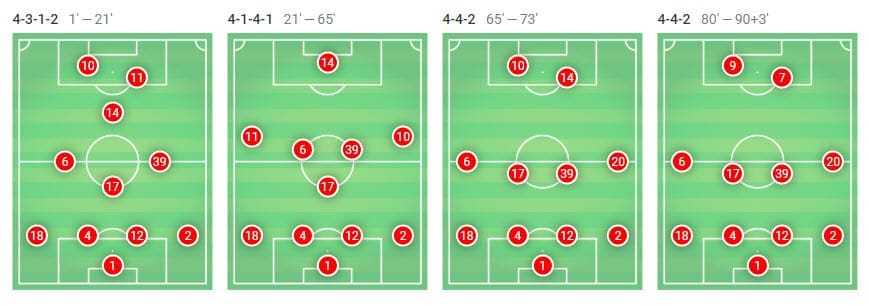
Manchester United come out swinging
It has to be noted that the guests arrived at the Camp Nou with a slightly altered plan to the one we saw at Old Trafford just a week ago. In the first leg, United were dominant in the way they pressed Barcelona and how they controlled the proceedings in their own backyard. Still, their only ways to attack were to get into good crossing positions or to find their main target-man, Romelu Lukaku, up front and start play after winning the first and second long balls into Barcelona’s first third.
This time around, however, they intended to play to their strengths far more, just as we expected them to do in the first leg. Exploiting the free space Barcelona so often leave behind with pace and good overall movement was first on the agenda, and it worked wonders against a still disorganised Catalan defence in the opening stages of the game.
Getting their forwards isolated with Barcelona’s centre-backs who generally lack pace was the ideal scenario that needed to unfold for Manchester United. But getting to the final third was actually achieved with intricate movement and some exceptional one-two football from the Red Devils.
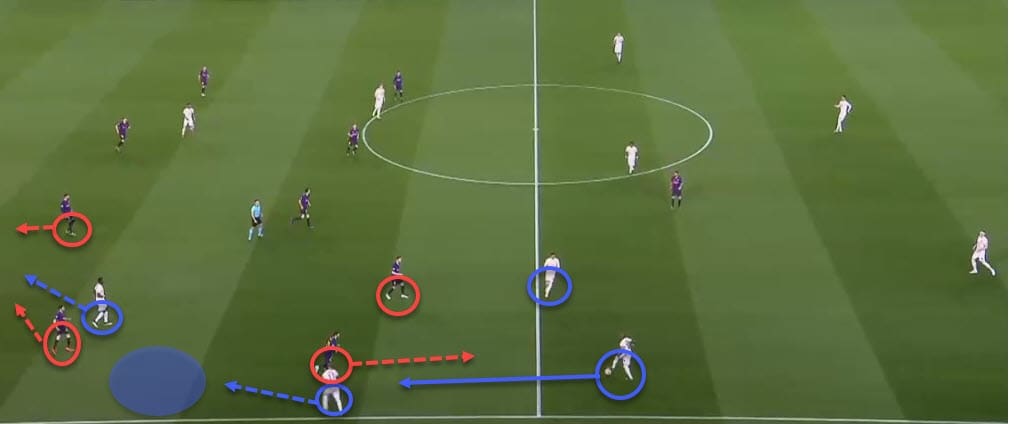
Notice in the example above how Pogba occupies both Gerard Piqué and Sergi Roberto with his run in behind while Ashley Young prompts Lionel Messi to press him, leaving Martial all alone hugging the touchline. This was the move that initially started United’s ball progression and entry into the final third. The overload they managed to achieve gave them the final ball to challenge Marc-André ter Stegen.
Pogba’s movement higher up the pitch, as well as Young’s relatively high positioning, made Barcelona deploy more men to compensate for the numerical inferiority that was starting to mount up on their right. Below, Lingard also drops slightly deeper, attracting the attention of two markers. Martial’s positioning is used as a stretching tool to allow Rashford to make a darting run and win a foot race United were predicted to be winning throughout the game.
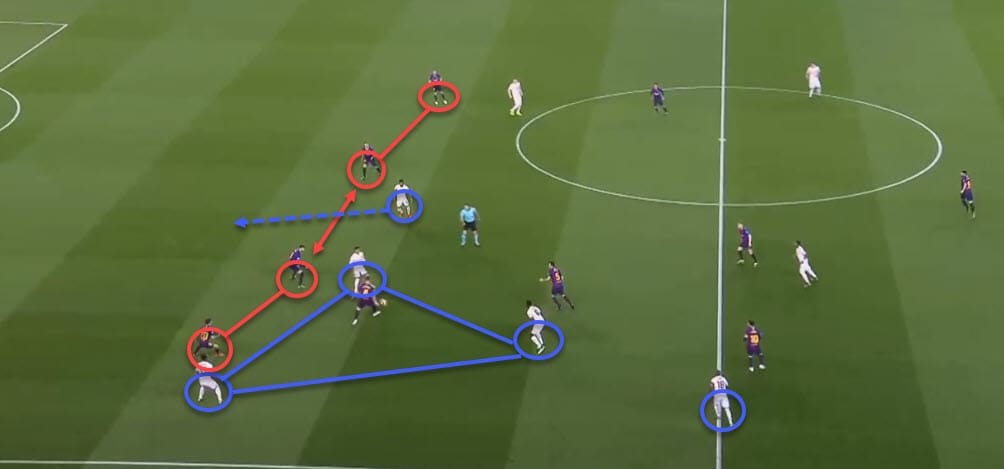
The second chance came practically just seconds after the first, and interestingly enough, following the same patterns. Manchester United make strides going through their left side, where 41% of all their attacks flowed, and attract markers from Barcelona.
And once again, like planned, the Catalans’ backline is stretched. More importantly, Manchester United get their one-on-one scenarios, or in this case 3v3, that come down to sheer pace more than anything else.
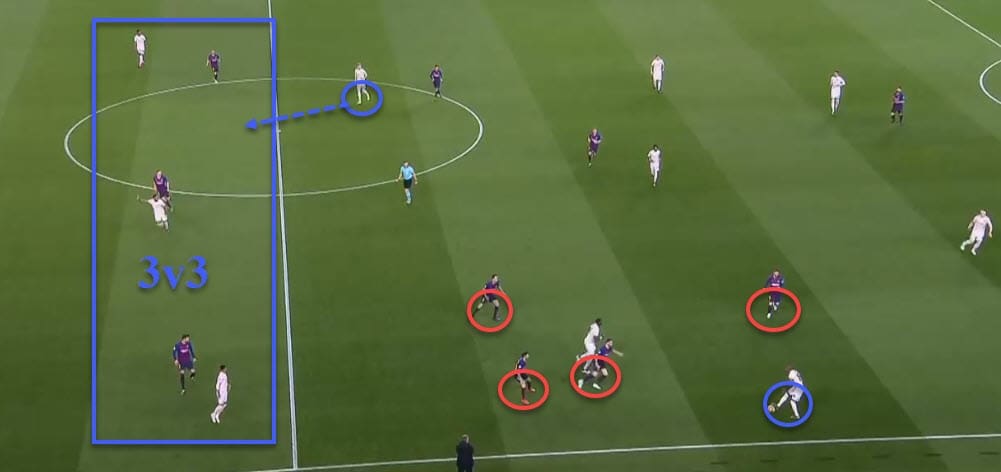
The final step was to take advantage of Barcelona’s press. Once their opponents deployed the majority of their personnel to cover their right flank, the left would get deserted and leave Alba in a 2v1 situation.
Creating these superiorities was key in making progress up the pitch and bypassing Barcelona’s pressing mechanism, as well as finally getting themselves in clear-cut situations that were, unfortunately for Manchester United, not exploited.
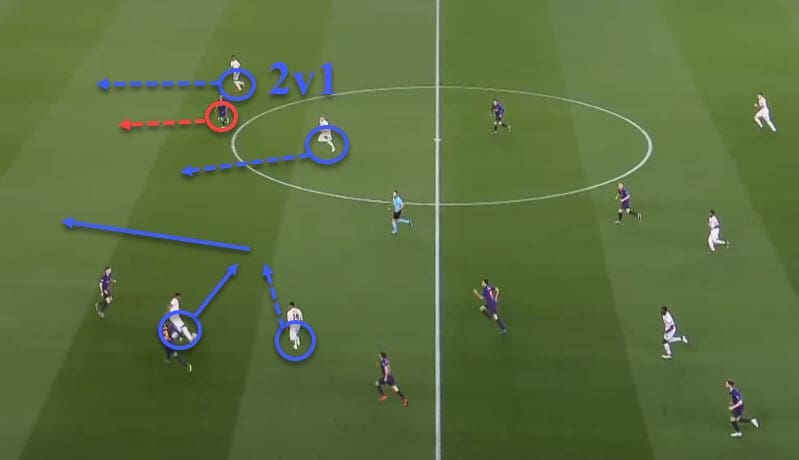
These early game jitters Barcelona were experiencing could have made the game that much more interesting. As it often stands in football though, when you miss your chances, karma is often just around the corner to punish you, and something like that happened to the English team.
Barcelona get a hold of themselves and establish their dominance
The home team suffered in the opening minutes of the game but soon they managed to restore balance and calmness into those hectic situations as they adjusted to Manchester United’s gameplan.
The visitors tried to be as aggressive as they were in the first leg, which was evident in the way they pressed or tried pressing Barcelona. Usually, the striker would go in first, initiating the press and followed by the two wide players. In general, this did not yield any real results for them as Barcelona’s three at the back had options to bypass their attempts.
Sergio Busquets was once again seen dropping between Piqué and Lenglet while Sergi Roberto and Jordi Alba made a midfield quartet with Arthur Melo and Ivan Rakitić. This was crucial in Barcelona’s build-up for a number of reasons. The example below is a default way the Catalans’ progressed the ball and bypassed Manchester United’s block.
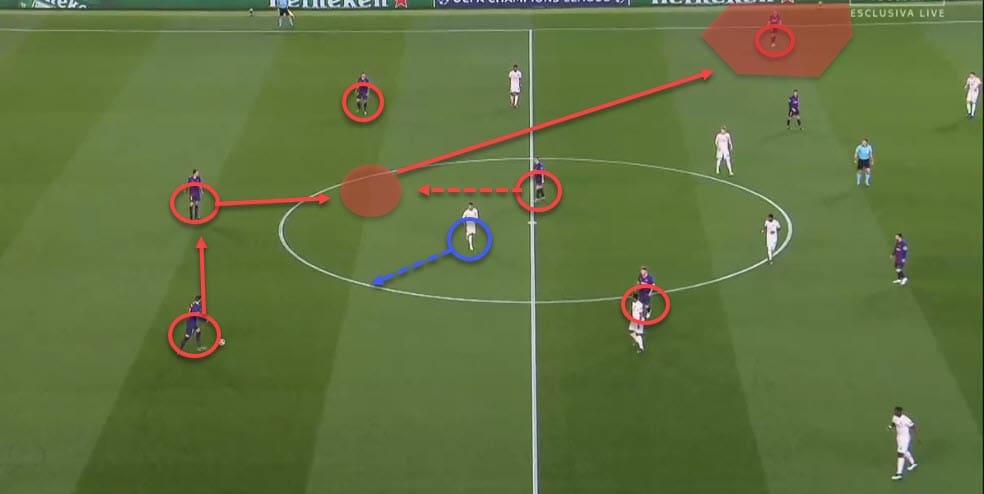
United do extremely well to block the entrance through the middle. But as soon as Lingard approaches the backline in an attempt of a press, space opens up behind him, and the home team advance the ball. The other thing worth noticing is how United’s narrow diamond shape allowed more freedom for Alba and Roberto respectively, and this is also evident from the image above.
The ball goes to Arthur as soon as the Brazilian creates enough space for himself to receive the pass, and then it circulates extremely quickly to the flanks and to Alba’s feet. This could have also been a part of Solskjær’s plan to force Barcelona onto the wings, but by doing so he gave them a tool to bypass his entire defensive block.
The Catalans also had an extremely dynamic midfield with Busquets, Rakitić and Arthur exchanging positions at all times. The build-up would start with Busquets assuming the lavolpiana position and attracting United’s press. As soon as the away team step into the opposition’s territory, the pieces start moving and Arthur drops deeper to receive the ball into his feet.
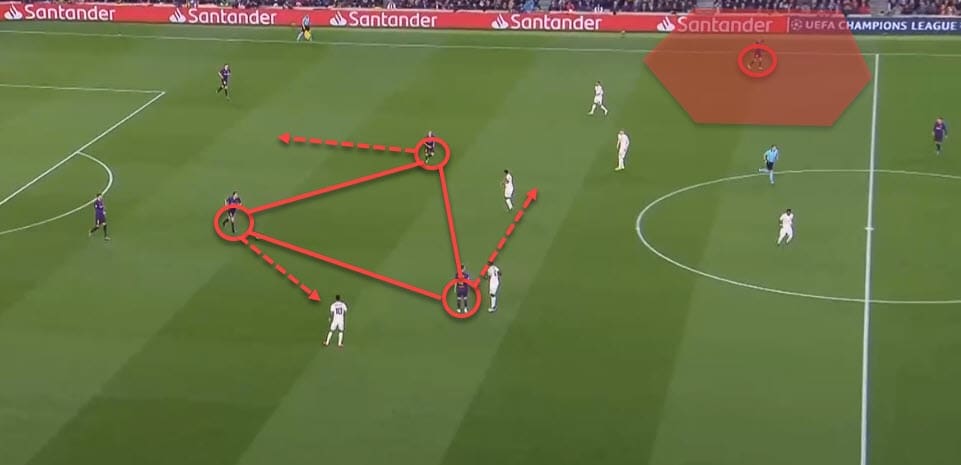
The next phase is to completely bypass the press by a shift in the midfield trident. Arthur steps into the lavolpiana, Rakitić moves to his place on the left, and Busquets follows by assuming the Croat’s vacant spot on the right.
This also moves the visitors’ personnel and their narrow shape gets exploited once again as Alba is easily found in an advanced position and sprinting into space behind the backline. United were forced to choose one of two options, both of which were bad for them: either press the backline and leave the flanks open, or give the backline space and time and cover the passing channels instead.
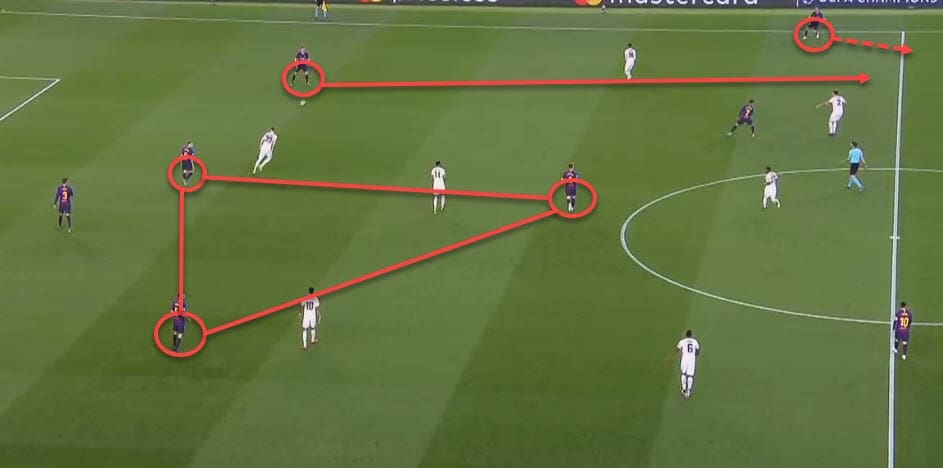
As we’ve seen from the examples above, neither option yielded them favourable results. Solskjær’s system was exploited by Barcelona and they mostly paid dividends for their narrowness. Still, it was the midfield battle that heavily lost and interestingly enough, players that shone last time buckled under the pressure in the return leg.
Fred was the man with most lost possessions on the night, while defensive blunders from the likes of Young and even more crucially, David de Gea, made any sort of comeback impossible for Manchester United.
Both teams target the same areas
We have already established how Manchester United preferred their left side to attack (41%) and it comes as no surprise that Barcelona did the very same thing (40% through their left flank), as so often happens in their games.
Giving Alba so much time to receive the ball and so much free space to run into proved to be lethal for United, which was to be expected. Preventing the Messi/Alba connection is defending 101 when playing against Barcelona. The visitors failed at that, which cost them the third and final goal of the evening.
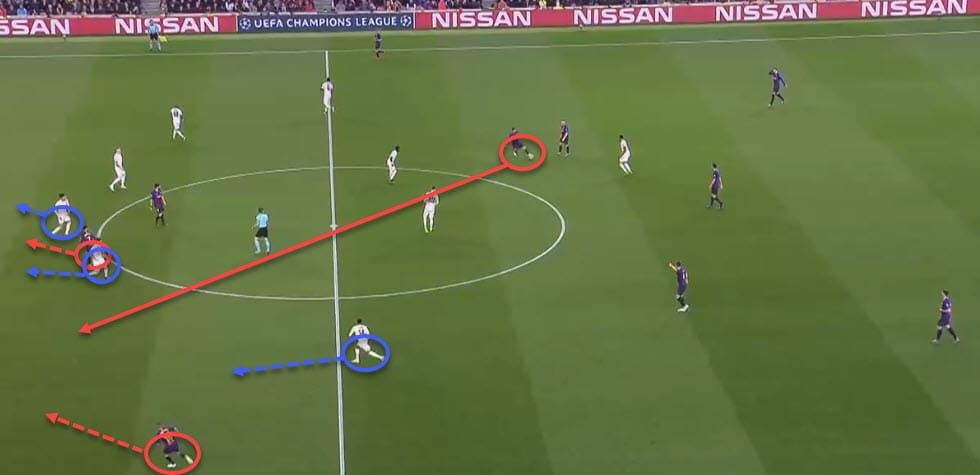
Once again Barcelona have no trouble playing out from the back, bypassing the visitors’ press and allowing Arthur to progress the ball forward, finding Messi all alone. United’s midfield apply no pressure on the Argentine, and their default narrow defensive shape allows Alba to sprint in behind completely unmarked.
A couple of touches later, Barcelona are in front of the goal, and the net is rippling from Coutinho’s thunderbolt. Interestingly enough, Manchester United tried the very same thing. With so much freedom to step forward, Alba never shied away from such a chance, which often meant that a good transition would be lethal to Barcelona.
In the end, all it could’ve given them was a consolation goal but ter Stegen made sure no such thing would be happening at the Camp Nou. For the first time in their history, Barcelona conceded just one goal in their first four games of the Champions League knockout stages.
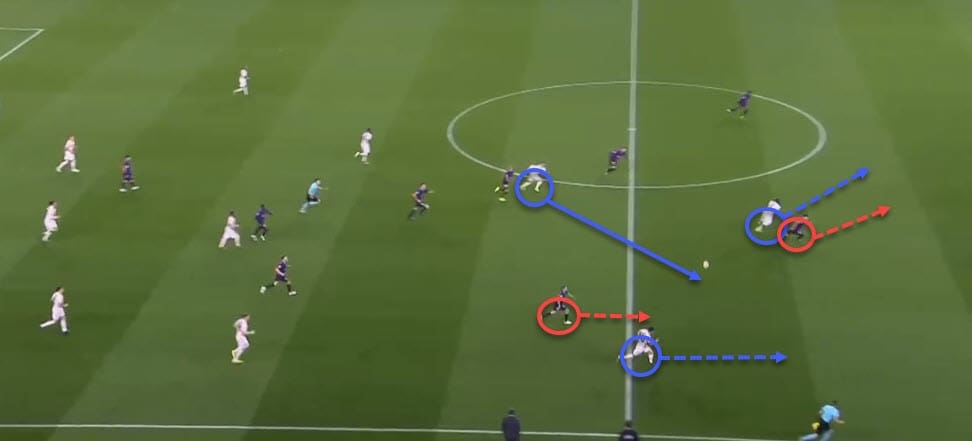
Manchester United were able to exploit the weakness they recognised in Barcelona’s system but alas it was not enough to give them an edge over the Catalans.
Conclusion
For the fifth time in their history, Barcelona have beaten Manchester United in a Champions League game, which makes the English team their favourite victim in the competition. This was a much closer contest than the scoreline might suggest, but the better team did progress in the end.
We now have our four semifinalists all locked in. The Blaugrana will host the red of Liverpool, while this year’s sensation, Ajax, face the other surprise candidate, Tottenham Hotspur.
The stage is set for the final stretch and the semi-finals can’t come soon enough.
If you love tactical analysis, then you’ll love the digital magazines from totalfootballanalysis.com – a guaranteed 100+ pages of pure tactical analysis covering topics from the Premier League, Serie A, La Liga, Bundesliga and many, many more. Buy your copy of the April issue for just ₤4.99 here, or even better sign up for a ₤50 annual membership (12 monthly issues plus the annual review) right here.

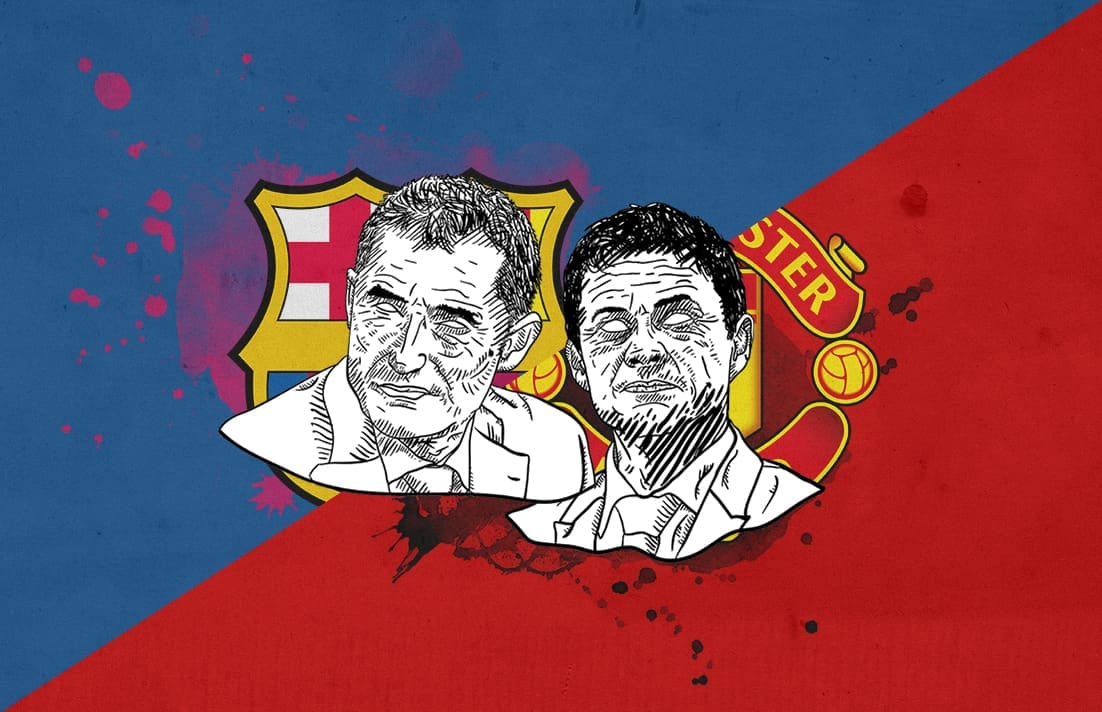




Comments